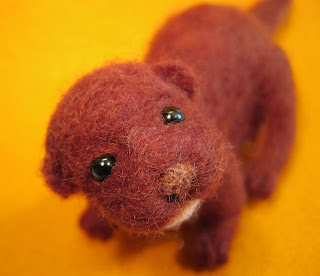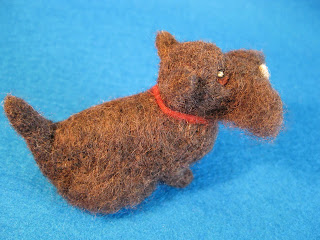
As promised, this entry will be all about the craft of needlefelting. (Pardon the late posting, but ill children take precidence over computer time. It's a well known fact!)
SUPPLIES
In order to start needlefelting, one only needs three supplies: wool roving, a barbed felting needle, and a foam block.
Where can one get the aforementioned items? Well, Google is always an option, but there are quite a few tried and true people (and companies) with whom I have had great experiences. A super place to start is http://feltingforum.com/. This resource has everything: detailed instructions, technical support, supplies, tutorials, and a network of people willing to help. Kay Petal is just an amazing gal. Check out the Needlefelting thread. You will be amazed at the quality of the work you find there.
A great spot for purchasing felting fiber is Speckled Ram at http://www.speckledram.etsy.com/. I have also purchased wool from A Child's Dream Come True, a store that sells natural toys and supplies at http://www.achildsdream.com/. Just make sure that the wool you order is fairly coarse- it felts much more quickly when using a needle. Many sites will sell Merino top, which is soft and lovely to the touch and nice for wet felting, but it can take a l-o-n-g time to needle felt.
Or you can try a local shop near you. Many yarn or needlework shops have started to carry fiber and felting needles. In Long Beach, CA , there is a tiny gem of a shop called MariPats. She carries all kinds of great fiber-y goodies.

WHAT IS NEEDLEFELTING?
Needlefelting is exactly what it sounds like; making felt while using a pronged needle. This craft has been on the scene for a while, but began gaining in popularity in the late '80's/early 90's. Basically, one takes a fluffy bit of wool roving, which is lofty and airy, and repeatedly stabs at the wool with a special needle. This barbed needle causes micro-knots to tangle the roving which condenses the wool down onto itself. The result is that the wool becomes denser, firmer and more shapely.On a side note, if one is careless while felting the roving, one can end up with extremely sore fingers and ahem...stained wool. The needles are incredibly sharp and it is easy to get into a rhythm and stop paying attention to the task at hand. Next thing you know, the Frosty the Snowman you were working on looks like a casualty of war.
Because needlefelted items aren't seen everyday, many people think it must be extremely difficult to do. People see the finished products created by felting and say, "I could never do that!"
The response to that is, "Not with THAT attitude, you big quitter." No..wait.. That is the response in my head. The real response is, "Give it a go. It isn't expensive to try and you may find that you love it!"

WHAT CAN I MAKE?
The wool will respond in very predictable ways. If you spread wool out over a foam block and needle in an area very deeply, it will flatten out and firm up quickly, forming a sheet of wool felt. If you form a tight ball using your fingers and gently needle all the way around it over a moderate period of time (again using a foam block as a base to work upon), you can create a variety of different shapes that can be refined to make characters, objects for nature tables, or toys.
There is no end to the kinds of items one can make. Vessels, figures with armatures, and items of clothing are all options. Embellishing different kinds of fabrics can be done as well.
Next time, I will attempt to provide a basic pictoral tutorial to give everyone a better idea of what it looks like when one is felting.
Until next time, happy crafting. And happy parenting, too!

Thanks for the insight. I've never tried needle felting, but I'm always impressed with the items I see made this way.
ReplyDeleteMy pleasure! You should give it a go!
ReplyDelete